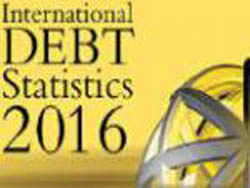
The world Bank (WB) published its latest statistical obsipo debt situation in the world – International Debt Statistics 2016. The survey covers 120 countries, according to the criteria of the WB belong to the category of countries with low and middle income (LMI countries).
The report contains detailed information on the external debt position of each of the 120 countries of the LMI. In addition, in many instances, it is supplemented by data on foreign investment that allows you to evaluate the role of capital inflows in the form of credits and loans in relation to total income of financial resources in the countries concerned. The report includes, in particular, all post-Soviet States.
The growth of external debt largest recipients of loans and credits
The total flow of capital to LMI countries in 2014 amounted to $ 1132 billion, and in the form of direct and portfolio investments – 667 bln. dollars, but in the form of loans and credits – 464 billion. It turns out that on loan capital had 2/5 (41%) total capital flows to the periphery of world capitalism (PMC).
Table. 1.
The flow of financial resources in 2014 in major regions of the world (billion dollars)*.
The region
Just
Loans
Direct and portfolio investments
East Asia and the Pacific
546
145
401
Europe and Central Asia
84
41
43
Latin America and the Caribbean
297
168
129
Middle East and North Africa
23
9
14
South Asia
103
54
49
Africa South of the Sahara
78
47
31
Total
1131
464
667
*numbers are rounded; therefore, totals of the numbers are a little do not coincide with the statistical data.
The largest recipients of funding were China, Brazil, India. In particular, 51% of the total capital in the form of direct and portfolio investments received 120 countries were in one country – China. Almost 52 % of all inflows in the form of loan accounted for three countries – China, Brazil and India.
Countries receive a PMK new loans and credits becomes a constant source of growth of their external debt. Here is the dynamics of the external debt 120 countries NCC in recent years (year-end; us $ bn.): 2000 – 1.743; 2005 – 2.091; 2009 – 3.175; 2010 – 3.631; 2011 – 4.079; 2012 – 4.564; 2013 – 5.056, 2014 – 5.392. As you can see, one and a half decades the absolute size of the external debt has increased 3.1 times.
The world Bank puts Ukraine in a category of the colonial appendages
In relative terms, the debt burden of countries due to external loans and credits, changed as follows:
Table. 2.
Relative indicators of external debt (VD), LMI countries (%)
Indicators
2000
2005
2009
2013
2014
The ratio of VD to the annual export
122,5
76,9
79,2
76,1
79,1
The ratio of VD to GNI*
34,6
25,3
22,1
21,8
22,2
The costs of providing the service of internal Affairs to the annual export
20,0
13,3
10,1
8,5
8,9
The ratio of international reserves to VD
30,4
79,8
131,2
120,8
113,5
*GNI – gross national income (Gross National Income). Close to the gross domestic product (GDP).
In General, the relative indicators of the debt burden of the countries of the PMC in 2014 looked much better than in 2000, and slightly better than in 2005 for Example, China’s ratio of external debt to annual exports amounted to only 34.8 percent; the ratio of external debt to gross national income was 9.3%; the cost of external debt service to annual exports up 1.9%; the ratio of international reserves to the external debt of 402.2%.
At the same time, in many countries the indicators are significantly worse than average. Will Take The Ukraine. In this country the ratio of external debt to annual exports was 184.5%; the ratio of external debt to gross national income – 100,3%; the cost of external debt service to annual exports of 25.2%; the ratio of international reserves to external debt is only 5.1 %. Relative indicators of debt burden, Ukraine was on the level of many underdeveloped countries in Africa, Asia, Latin America, which are called colonial appendages of the West.
The last data included in the table.2, are 2014. There is reason to believe that after this debt situation in the LMI countries has deteriorated. Most of them are countries specialized in the export of natural resources, agricultural raw materials and food. In 2015 there was a decline in the prices of these commodities on the world market. Occurred a reversal of capital flows in the opposite direction: from the periphery to the center of the world capitalist system. In addition, there has been an increase in interest rates on borrowings. Duty was the phrase: “Raw materials are getting cheaper, money is getting more expensive”. Finally, the falling rates in many countries has led to a decrease in the value of international reserves (as a result of massive foreign exchange interventions for the protection of national currency units). According to other sources, the size of the external debt of countries of the PMC in 2015 was lower than their international reserves.
Structure of external debt
External debt is divided into long term and short term. In 2000, on long-term debt accounted for almost 84% of the total external debt of countries of the LMI. In subsequent years this percentage was (%): 2005 – 78; 2009 – 74; 2013 – 69, 2014 – 70. Thus, for a decade and a half of long-term debt share shrank, but still more than twice short-term debt.
Long-term external debts, in turn, are divided into public and private debts. External public debt – a state’s obligations under received loans and borrowings and guarantees issued. Here is how was changed the share of public debt in total long term external debt of countries UAA (%): 2000 – 72; 2005 – 69; 2009 – 54; 2013 – 51; 2014 – 51. That is, the state’s share in total external debt declined. Currently public and private debts equal in magnitude. Consider the structure of government debt more (table. 3).
Table. 3.
The composition of long-term public external debt of LMI countries (billion us dollars).
2000
2005
2009
2013
2014
Just
1.053
1.116
1.268
1.789
1.943
Official creditors
648
652
737
870
869
Including the IMF
53
51
129
113
97
Private lenders
408
508
531
919
1.074
Including loans in the form of debt securities
81
115
188
353
395
Firstly, a notable change in the proportion of official and private creditors in public debt. In 2000, the share of official creditors was 61.5%, while the share of private creditors is 38.5%. In 2014, the debt had already private creditors (55%), and official lenders were in second place (45%). Secondly, among the official creditors, the international monetary Fund is surprisingly modest (on average about 10%). Thirdly, there was a tendency to increase the role of loans in the form of debt securities issued by States unauthorized access. In 2000, loans accounted for only 20% of the loan capital provided by private lenders States, and in 2014 this indicator was already 37%. However, still the basic means of attraction of loan capital countries LMI is to obtain traditional Bank loans.
Prosperity in debt
And it looks like the debt situation in low-and middle-income background in the economically developed countries? Here’s an interesting picture.
Table. 4.
Gross external debt of economically developed countries* (trillion dollars).
2010
2011
2012
2013
2014
Just
64,05
66,99
69,66
71,44
69,99
The G7
USD 40.46
42,61
43,94
44,28
A 44.25
Other countries
23,59
24,37
And ensured 25.72
27,16
25,74
*Countries belonging to Organization for economic cooperation and development (OECD)
Over the five-year period 2010-2014 in absolute terms, gross external debt (gross external debt) of economically developed countries has increased by 6 trillion. $ or 8.5%. The economically developed countries in the report are member States of the OECD, their number is currently equal to 34. At seven leading countries (USA, Canada, Japan, UK, Germany, France and Italy) account for about 63% of the gross external debt of all OECD countries. The bulk of gross external debt owed by the banking sector, in second place – other sectors of the economy, the state in third place. The report is called the sum of the external public debt as of December 31, 2014 – about 16 trillion. $ .
So, a picture of the credit situation in the world, divided into countries of “Golden billion” (34 States) and the periphery of world capitalism (120 States), the result is very contrasting. Total external debt in the first group of countries amounted to 70 trillion. $ . against 5.4 trillion. $ . in the second group. The gap almost in 13 times. No less impressive looks the comparison of relative indicators of the debt burden. According to world Bank data, the ratio of the gross external debt of the economically developed countries in terms of their combined gross domestic product (GDP) in 2014 was equal to 140%. This is 6.3 times higher than in countries with low and middle income countries. 140% of average. In Canada, the figure is 83%, in Germany – 145%, and in the UK – 313%.
Not so long ago in the Economics textbooks argued that the country’s economic situation depends on the value of its external debt. The higher the debt level, the worse the situation. From this perspective, Britain and many other countries in the West should be declared bankrupt: their debt obligations in dozens of times higher than their international reserves and other liquid assets. However, these countries not only exist, but thrive. This is the new form of debt parasitism, covered with Fig leaves “rating” of leading Western agencies.







